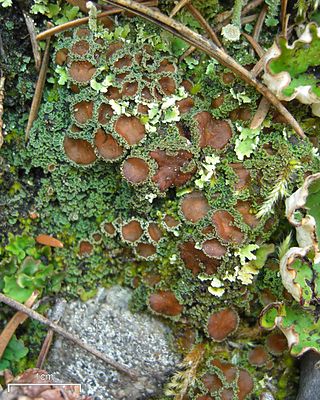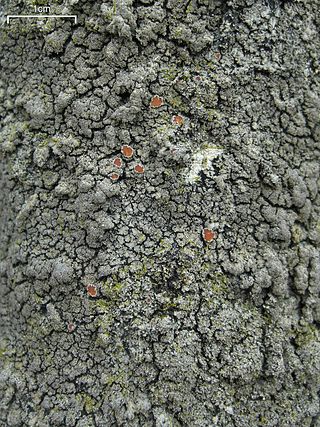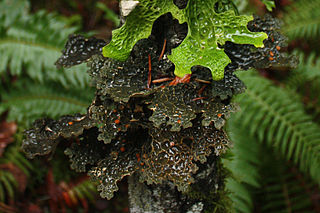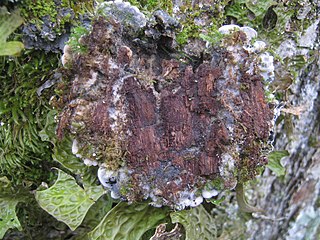
The Pannariaceae are a family of lichens in the order Peltigerales. Species from this family have a widespread distribution, but are especially prevalent in southern temperate regions.

Sticta is a genus of lichens in the family Peltigeraceae. The genus has a widespread distribution, especially in tropical areas, and includes about 114 species. These lichens have a leafy appearance, and are colored brown or black. Sticta species with cyanobacteria as photobionts can fix nitrogen from the atmosphere, and due to their relative abundance and high turnover, they contribute appreciably to the rainforest ecosystem. They are commonly called spotted felt lichens.

Psoroma is a genus of lichen-forming fungi in the family Pannariaceae. The widespread genus contains about 30 species, most of which are found in south temperate regions.

Parmeliella is a genus of lichenized fungi in the family Pannariaceae. It occurs mainly in the tropics and sub-tropics, with species found in Africa, Asia, Australasia and South America. A recent (2020) estimate places 41 species in the genus.

Pannaria is a genus of lichen-forming fungi in the family Pannariaceae. The widespread genus contains an estimated 51 species, found primarily in tropical regions.

Degelia is a genus of lichen-forming fungi in the family Pannariaceae. The genus is named after Swedish lichenologist Gunnar Degelius.

Thelidium is a genus of lichen-forming fungi in the family Verrucariaceae. The genus was circumscribed in 1855 by Italian lichenologist Abramo Bartolommeo Massalongo, who assigned Thelidium amylaceum as the type species.

Leptogium is a genus of lichen-forming fungi in the family Collemataceae. It has about 110 species. Species formerly classified under Leptogium have since been divided among the genera Leptogium, Pseudoleptogium, and Scytinium. Leptogium lichens are predominantly found on tree bark or soil, often among mosses, and sometimes on rocks in moist environments.

Rhizocarpon is a genus of crustose, saxicolous, lecideoid lichens in the family Rhizocarpaceae. The genus is common in arctic-alpine environments, but also occurs throughout temperate, subtropical, and even tropical regions. They are commonly known as map lichens because of the prothallus forming border-like bands between colonies in some species, like the common map lichen.

Pseudocyphellaria is a genus of large, leafy lichens that are sometimes referred to as "specklebelly" lichens. The genus has a widespread distribution, especially in south temperate regions, and contains about 170 species. They resemble Lobaria, except that most species of Pseudocyphellaria have conspicuous pseudocyphellae on their lower surface, a characteristic that was once considered unique to this genus. Some species contain pulvinic acid-related pigments; in these species the soredia and pseudocyphellae can be bright yellow.
Siphula is a genus of lichenized fungi in the Icmadophilaceae family. The widespread genus contains about 33 species. Siphula was circumscribed by Swedish mycologist Elias Fries in 1831.

Degelia plumbea is a species of grey to blue-black or brown foliose lichen in the genus Degelia. It mostly grows on trees in undisturbed woodlands but occasionally on coastal rocks. It is found widely in Britain and western Ireland as well as in America and Canada, as it grows in maritime Atlantic climates.

Degelia cyanoloma is a species of blue-grey to lead-grey foliose lichen in the genus Degelia. It mostly grows on mossy trees in undisturbed woodlands. It is found in the Scottish Highlands, western Ireland and Norway, as it grows in maritime Atlantic climates.
Peter Wilfred James (1930–2014) was an English botanist and lichenologist. He was a pioneer in the study of lichens as environmental indicators, especially of atmospheric pollution.

David John Galloway, FRSNZ was a biochemist, botanist, and lichenologist.

Gunnar Bror Fritiof Degelius was a Swedish lichenologist. Between the publications of his first and final scientific papers, Degelius had a 70-year-long research career. While he was best known for his expertise on the lichen genus Collema, he also wrote important papers on lichen biology and ecology, floristic studies of the Nordic countries and various other areas around the world, and lichen succession. Degelius described 124 new taxa, and published about 130 scientific papers. In 1992 he was one of the first to be awarded the Acharius Medal for his lifetime contributions to lichenology. Fifteen species and three genera have been named in honour of Degelius.
Gibbosporina is a genus of 13 species of foliose lichens in the family Pannariaceae. It contains species that molecular phylogenetic analysis clustered together in a clade previously referred to as the "Physma"-group. Despite their morphological differences, this group shares several uniting characteristics. They have ring-like excipular margins around the thallus; strongly amyloid internal ascus structures; well-developed perispores that feature irregular gibbae, but not verrucae ; lacks secondary compounds than can be detected by thin-layer chromatography; and have tropical distributions.

Solenopsora is a genus of lichen-forming fungi in the family Catillariaceae. It has 15 species, with a mostly Northern Hemisphere distribution.
Gustaf Einar Du Rietz was a Swedish botanist and lichenologist. His research interests included plant ecology, lichen taxonomy, and biogeography. He was a leading figure in the Uppsala school of phytosociology–the study of groups of species of plants that are usually found together–and is recognised for his role in advancing this field of science and for mentoring future lichenologists. He led the Swedish Australasian Botanical Expedition of 1926–27, a seven-month research tour of various locations. He was married to Greta Sernander, who was also a lichenologist. During the expedition, Du Rietz and his wife researched the vegetation in New Zealand, Australia, and Java, focusing on mountain lichens and their potential as bioindicators for environmental conditions. They collected around 3000 specimens, contributing significantly to the study of bipolar lichens and forest ecology, despite challenges in processing all the samples upon return to Sweden. Several species have been named in his honour. In 1949, Du Rietz was elected to the Royal Swedish Academy of Sciences and contributed significantly to nature conservation efforts in Sweden.
Placolecis is a genus of lichen-forming fungi in the family Catillariaceae. It has four species of saxicolous (rock-dwelling) and crustose lichens. The genus was circumscribed by Italian botanist Vittore Benedetto Antonio Trevisan de Saint-Léon in 1857. He did not assign a type species for the genus. Josef Hafellner designated a lectotype for Placolecis balanina in 1984, but subsequently, this taxon was folded into P. opaca.












